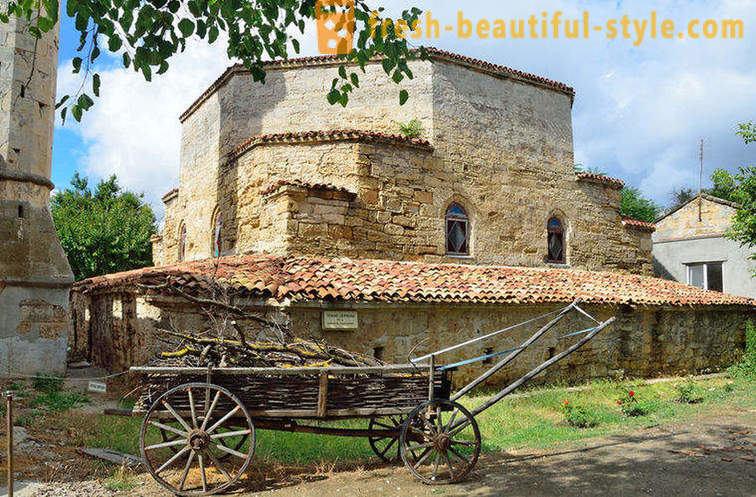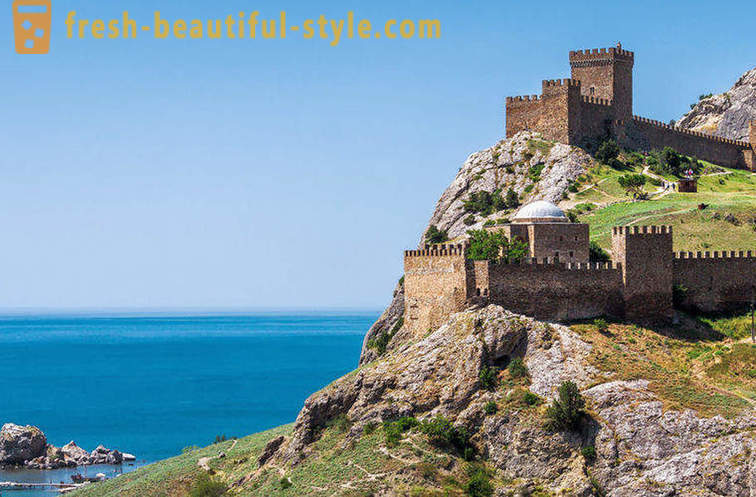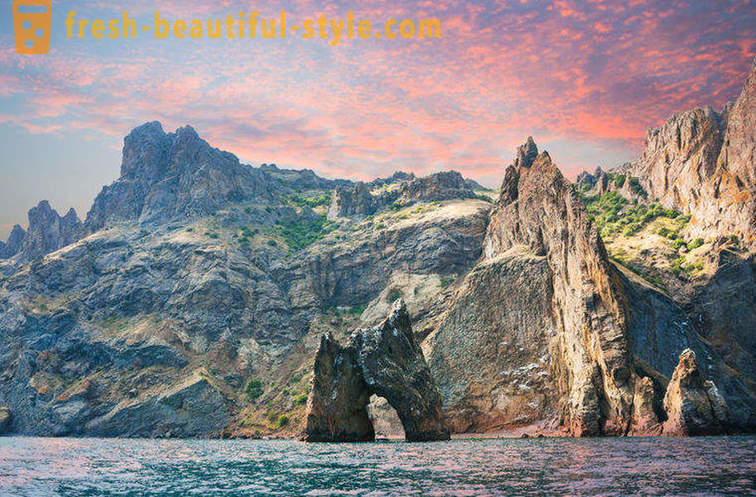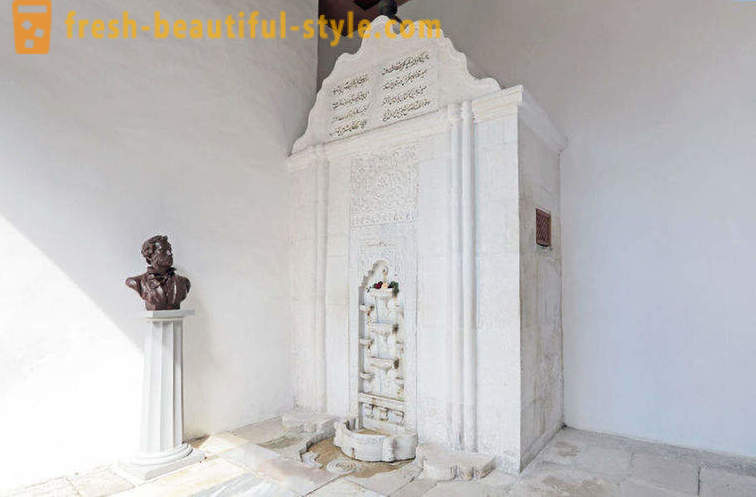What to see in the Crimea
Six places and experiences, without which the rest of the peninsula will be incomplete.

Yevpatoria: stroll along the Crimean Jerusalem

a maze of narrow streets of the Old Town Yevpatoria immersed in the world of the medieval past. Cultural history Kezlev (as in the Crimean Tatar language called Yevpatoriya) surprisingly diverse. On the pedestrian route "Little Jerusalem" you meet and a synagogue, and the Karaite kenassas, and a mosque, as well as the Orthodox churches and the Armenian Church.
The route starts at the city gates Audun Kapusy Bazaar, built in the XV century, and leads to Tekie dervishes, monastery, which, incidentally, is one of the first places of worship not only Yalta, but the whole of the peninsula. It is the only remaining refuge religious ascetics in the territory of the former USSR.

Next on the route is one of the few synagogues existing Crimea - Egie-dripping. This craft synagogue, where most profess liberal trend - Progressive Judaism. The main decoration of the synagogue - the altar, as it should be focused on Jerusalem. It is here that houses the main relic Egie-Kapan - a Torah scroll.
The Khan Mosque Juma Jami also give tours. A single ticket allows you to visit all of the route objects. The town Yevpatoria small and incredibly colorful - from objects of antiquity to the cafes of the Crimean Tatar cuisine, which caught here and there.
Sevastopol: visit the cave city

In the half-hour drive from Sevastopol on the picturesque valleys rises the plateau of Mount Baba Dag ( "Desperate Mountain"), which is a mysterious cave city Mangup-Kale. On the plateau is a winding dirt road, you can climb up with experienced guides for off-road (entrance fee). If you are not willing to classify themselves as fans of extreme sports, go up into the mountain by one of several hiking trails. After rising to a height of 580 m, you understand why this place was chosen for the city-fortress and why he so long remained inaccessible to the Turkish forces. From any point of the plateau offers stunning beauty of the panorama of the valley, and in the good weather here can be seen even the coast of Sevastopol.
The early history of the town is little known and controversial. Historians suggest that the walls began to be erected in VI century. In IX-X century fortress, according to some sources, it belonged to the Khazars. But most scholars studied during the XIII century, when it housed the legendary capital of the principality of Theodoro, captured by the Turks after a long siege in 1475. The last inhabitants Mangupa become Karaites, who have lived here for over 300 years, leaving the city at the end of the XVIII century.
Most impressed by a visit to the citadel Mangup produces at Cape Teshkli-breaker. The remnants of a powerful defensive wall fencing off the cape of the plateau, and in the rock face perfectly preserved carved caves. In each of them you can go down the stairs. Besides that Mangupa inhabitants lived in cave houses, there is a temple, monastery dormitory, prison cells, utility rooms and corrals.
Simferopol: to become a Viking for a day

To make it fully possible in the Movie Park "Viking" near Simferopol, the basis of which were the sets for the same film. Atmosphere and Park device fully comply with the real medieval Borghi major city Viking times VIII-XI centuries.
Here come alive Scandinavian sagas of the ancient pagan gods and Varangians, mentioned in the chronicles of Kievan Rus. Each building is decorated with ancient ornaments and amulets. Even the kitchen is the most authentic, restored, they say, according to ancient recipes.

In the park, you can try on armor and costumes that correspond to the times, to get acquainted with the medieval crafts, archery, forge a sword and take part in an impromptu battle. Superstitious especially hard to go past the fortune-teller home. Redhead prophetess throwing runes and reveals the secrets of fate. Believe it or not - everyone decides for himself.
Sudak: to feel like a medieval sentinel

Genoese fortress, the main attraction of the town of Sudak - the perfect backdrop for filming historical films, of which there are in this picturesque area was filmed a lot. The fortress stands in its present form over the city for 600 years, and thousands of years ago there was a huge coral reef.
Until now, historians argue, who laid the stone walls of the fort - the Alans or severe Scythians. At different times, the fortress conquered the Khazars, Polovtsy, Byzantines, Mongols and Tatars, but the most important place in the history of these places played Genoese. Captured their territory - from Kherson to the Bosporus - it was necessary to protect and maintain, so Pike becomes the basis of Italian merchants and consuls.
Climbing to the highest point of the fortress - a two-story watchtower Kiz-kul - and looking round all Sudak valley, you feel like a real medieval sentinel. In clear weather, it is visible even Ayu-Dag and the top of Ai-Petri.
Watch tower is better known as the Maiden, and that it is associated with one of the most romantic legends of Crimea - on the governor's daughter, fell in love with a commoner and rushing out of the impossibility of such a union from the walls of the tower into the sea.
Koktebel: make a wish at the Golden Gate

To get to Koktebel business cards can be only from the sea. Golden Gate - is the rock at the foot of the mountain, a volcanic massif Karadag. Straight from the sea rise fancy stone "gate". Several centuries ago, the famous landmark called the Shaitan-kapu, which means "devil's gate." Local believed that this is where the entrance to the hell of fire. And now, many scientists believe that in the myths of ancient Greece, Heracles and Odysseus descended into Hades from here.
The sun illuminates the rock of basalt gold, but is considered to be a special good luck to see the sunrise through the Golden Gate of the Kara-Dag. You can do this only a few days a year, but to make a wish - every day. Passing the stone arch of the Golden Gate, you need to think about the intimate and throw a coin. If it hits the loud rock, then, as promised conductors wish will come true.
Bakhchisaray: to unravel the secret signs Fountain of Tears

The famous Fountain of Bakhchisarai shrouded in romantic legends.
Fountain, erected in 1764 by the Iranian artist Omer refers to Selsebil type. The word is taken from the Koran - namely a source of drinking water will Selsebil the just soul of the garden. Indeed, if a long look at the Fountain of Tears, start to think about eternity.
It is decorated with surahs from the Quran and verses of poems, and in its form echoes the Tree of Life from the Kabbalistic philosophy. At the top of the cut flower of five petals symbolizing the human face. The water slowly flows down, emerging from the grotto, and fills three tiny pools, representing the mind, heart and soul. At the foot of the monument Omer arranged in a spiral pattern snail - centripetal path to God. According to legend, the "fountain of love Fountain of living" before an ornament is not the courtyard of the Khan's palace and the tomb of his beloved wife Crimean Khan Giray Dilara Bikech. Dilara personality has not yet been established. According to legend, it was a lovely young girl, or a Georgian, or Circassian, and perhaps a Greek named Dinorah Hionis. Love formidable Khan for her knew no bounds, but it was unrequited. Jealous Zarema, one of the wives of the Khan, drowned beautiful Dilara. Khan Giray, whose subjects considered heartless, was inconsolable after learning of the death of a young girl.













































